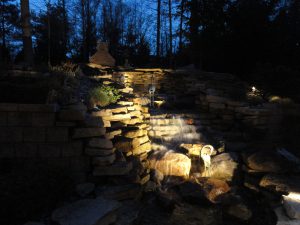There are many factors and decisions that go into illuminating an outdoor space. Adding lighting to a water feature is a great opportunity to elevate a backyard.
 When adding lighting to a water feature, the placement of the light needs to be carefully considered. Improper lighting can be blinding, even in the water. A good rule to follow is always place the light facing away from the viewing area.
When adding lighting to a water feature, the placement of the light needs to be carefully considered. Improper lighting can be blinding, even in the water. A good rule to follow is always place the light facing away from the viewing area.
The goal of the lighting should be to highlight aspects of the water feature. Angle lights away form the main viewing area. Many lights are small enough to be placed in the water and to be hidden within the rocks around the edge of the pond. Lighting should appear seamless and enhance the natural features.
The amount of lighting you use depends on your goal for the space. More lights will obviously make a feature brighter and have more contrast at night. Although, adding too much lighting can have a poor effect. If you have a lot of focal points that you want to highlight, use as many lights as needed to illuminate the area. You should want to focus on the main aspects of the water feature that draw the most interest. For example, you would not want to place a light into a stream that is flat with not a lot of water movement. By placing the light on the falls of stream beds and waterfalls, you create a more visually interesting feature at night.
The shadows cast on buildings from the movement of water and light will create a very dynamic effect that will make a lasting impression. Another tip for light placement is to stagger the lights throughout the landscape or area to create balance. The goal is to move the viewers eye through the entire space, using too much light in the foreground will prevent viewers from experiencing the entire water feature.












